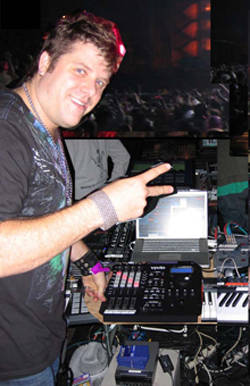V-Squared Labs elevates concert experience with multimedia creations
by Andrew Frey
November 2011

Vello Virkhaus
A visual revolution has been brewing in the image rendering and video projection realms transforming musical events into an entirely new multi-level experience. On Oct. 19, I was fortunate enough to attend a sold out Amon Tobin show in Denver at the Ogden Theater during the highly acclaimed ISAM tour and witness one such multimedia experience.
Objects resembling giant, white Tetris blocks on the stage were suddenly transformed into living video art that throbbed and pulsed along with the music. Audience members visited outer space when we saw spaceships fly by and explode in amazing high definition imagery. We saw cyber machines chug and churn before morphing into green blocks of electric contemplation and much, much more.
VSquared Labs, the North Hollywood company headed by Vello Virkhaus, created the entrancing imagery.
The company boasts impressive clientele. They’ve worked with everyone from Sting to Drake to 50 Cent and Gwen Stefani to push the boundaries of live performance and usher in a new level of video theatrics. After the show, I had a chance to correspond with Vello.
Can you explain what exactly you do?
What we do is create immersive, visual experiences. These happenings are often paired to musician(s) and live concert performances. The works we create are displayed on a wide variety of video display technologies concurrently to the musical performance. Some works run from the audio, termed audio reactive or generative visuals. Some video plays in sync to the performance triggered [using] a wide variety of syncing methods like time code, midi and DMX. We create these video experiences by using digital content creation software packages. In our field of work, we typically create concept imagery first. These initial concepts paired with written creative become the core blueprint for creative decisions to follow. We execute this blueprint in studio creating all the components. A client is then presented with viewing movies via the Internet and we get comments on creative/ideas. This process happens again, sometimes three times until we deliver the assets/experience.
How many projects do you work on per year or at one time?
We work on several projects at once and typically do about 10-15 major projects a year.
How long does it take to complete your projects on average from concept to stage show?
Anywhere from one month to one year. Every project is different based on the timeline and budget.
How many people typically work on a project?
There is no fixed number here. Minimum core team is six people. We have had up to 25 people on a project. We rise and fall like the tides.
Who generates the images? How much input do the artists have?
The images are generated by our staff or production partners like Leviathan. Each artist is typically given a concept board and is given a good range of creative freedom. I encourage creative experimentation and love watching new ideas grow.
Do any of your shows use more than one projector?
Yes they do. Drake used four projectors. We are currently doing 6-10 projector installations.
If you used more projectors would you be able to project an image ‘in the round’?
Absolutely. We can project on any geometric or architectural surface. Utilizing edge blending and mesh-warping technology, we can cluster projectors in dense radial and linear formations.
What are some of the key components that made this technology possible?
Really fast gaming graphics cards, iPad with touch OSC, lots of talented artists and derivative touch designer.
What kind of software do you use?
Derivative Touch Designer, Maya, Cinema 4D, Adobe Creative Suite. Touch is very customized. We use a lot of plug-ins in after effects and C4D. It takes forever to install all the plug-ins necessary
Could this technology become the future of cinema?
I think 3D mapping is definitely a part of the future of cinema as it brings mundane spaces to life in public architecture, transformation, transportation, illusion and suspension of belief, all things future cinema will be about. It definitely gets us far away from the 16x9 flat screen.
What is the next level?
The next level for me is producing even more intricate visual experience with further advanced interactive and generative techniques. I would love to do a permanent architectural mapping installation on a famous landmark building.
If someone wanted to get into your field, what kind of background would they have to have?
It always helps to have design and animation training. I would also suggest a strong education in video production and interactive programming. One could just enter the live entertainment market and learn in the field… which sometimes is the only way you figure things out in our market.
Projects on the horizon?
Lots, but all top secret.